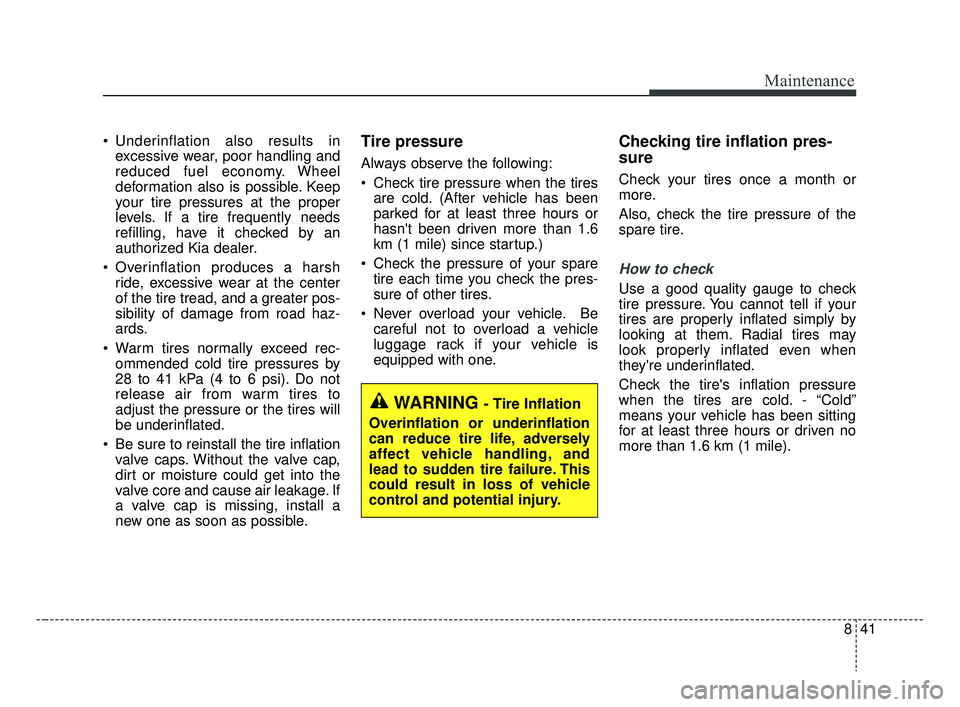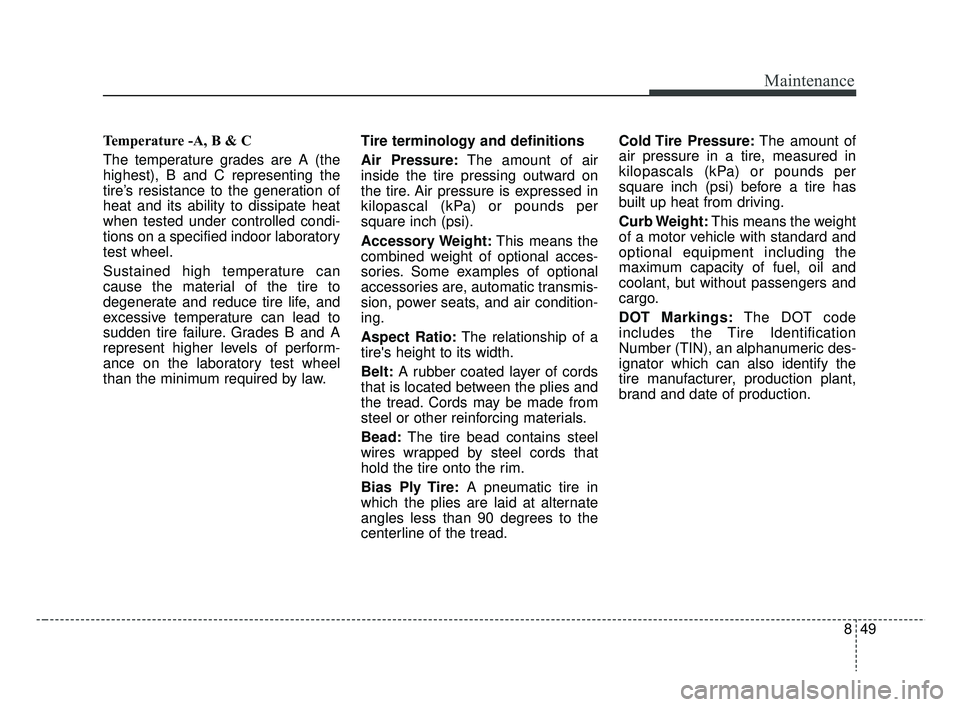Page 413 of 503

841
Maintenance
Underinflation also results inexcessive wear, poor handling and
reduced fuel economy. Wheel
deformation also is possible. Keep
your tire pressures at the proper
levels. If a tire frequently needs
refilling, have it checked by an
authorized Kia dealer.
Overinflation produces a harsh ride, excessive wear at the center
of the tire tread, and a greater pos-
sibility of damage from road haz-
ards.
Warm tires normally exceed rec- ommended cold tire pressures by
28 to 41 kPa (4 to 6 psi). Do not
release air from warm tires to
adjust the pressure or the tires will
be underinflated.
Be sure to reinstall the tire inflation valve caps. Without the valve cap,
dirt or moisture could get into the
valve core and cause air leakage. If
a valve cap is missing, install a
new one as soon as possible.Tire pressure
Always observe the following:
Check tire pressure when the tiresare cold. (After vehicle has been
parked for at least three hours or
hasn't been driven more than 1.6
km (1 mile) since startup.)
Check the pressure of your spare tire each time you check the pres-
sure of other tires.
Never overload your vehicle. Be careful not to overload a vehicle
luggage rack if your vehicle is
equipped with one.
Checking tire inflation pres-
sure
Check your tires once a month or
more.
Also, check the tire pressure of the
spare tire.
How to check
Use a good quality gauge to check
tire pressure. You cannot tell if your
tires are properly inflated simply by
looking at them. Radial tires may
look properly inflated even when
they're underinflated.
Check the tire's inflation pressure
when the tires are cold. - “Cold”
means your vehicle has been sitting
for at least three hours or driven no
more than 1.6 km (1 mile).
WARNING - Tire Inflation
Overinflation or underinflation
can reduce tire life, adversely
affect vehicle handling, and
lead to sudden tire failure. This
could result in loss of vehicle
control and potential injury.
SC CAN (ENG) 8.qxp 7/18/2018 5:33 PM Page 41
Page 421 of 503

849
Maintenance
Temperature -A, B & C
The temperature grades are A (the
highest), B and C representing the
tire’s resistance to the generation of
heat and its ability to dissipate heat
when tested under controlled condi-
tions on a specified indoor laboratory
test wheel.
Sustained high temperature can
cause the material of the tire to
degenerate and reduce tire life, and
excessive temperature can lead to
sudden tire failure. Grades B and A
represent higher levels of perform-
ance on the laboratory test wheel
than the minimum required by law.Tire terminology and definitions
Air Pressure:
The amount of air
inside the tire pressing outward on
the tire. Air pressure is expressed in
kilopascal (kPa) or pounds per
square inch (psi).
Accessory Weight: This means the
combined weight of optional acces-
sories. Some examples of optional
accessories are, automatic transmis-
sion, power seats, and air condition-
ing.
Aspect Ratio: The relationship of a
tire's height to its width.
Belt: A rubber coated layer of cords
that is located between the plies and
the tread. Cords may be made from
steel or other reinforcing materials.
Bead: The tire bead contains steel
wires wrapped by steel cords that
hold the tire onto the rim.
Bias Ply Tire: A pneumatic tire in
which the plies are laid at alternate
angles less than 90 degrees to the
centerline of the tread. Cold Tire Pressure:
The amount of
air pressure in a tire, measured in
kilopascals (kPa) or pounds per
square inch (psi) before a tire has
built up heat from driving.
Curb Weight: This means the weight
of a motor vehicle with standard and
optional equipment including the
maximum capacity of fuel, oil and
coolant, but without passengers and
cargo.
DOT Markings: The DOT code
includes the Tire Identification
Number (TIN), an alphanumeric des-
ignator which can also identify the
tire manufacturer, production plant,
brand and date of production.
SC CAN (ENG) 8.qxp 7/18/2018 5:34 PM Page 49
Page 497 of 503

Index
4I
Engine oil ......................................................................8-\
21Changing the engine oil and filter ..............................8-22
Checking the engine oil level ....................................8-21
Engine start/stop button ..................................................6-8 Engine start/stop button position ..................................6-8
Illuminated engine start/stop button ............................6-8
Explanation of scheduled maintenance items ..............8-16
Exterior overview ............................................................2-2
Forward Collision-avoidance Assist (FCA) system (Radar type) ................................................................6-39Brake operation ..........................................................6-42
FCA warning message and system control ................6-41
Limitation of the system ............................................6-45
Sensor to detect the distance from the vehicle in front (front radar) ..............................................................6-43
System malfunction ....................................................6-44
Fuel filler lid ..................................................................4-42 Closing the fuel filler lid ............................................4-42
Opening the fuel filler lid ..........................................4-42
Fuel requirements ............................................................1-3 Do not use methanol ....................................................1-5
Fuel Additives ..............................................................1-5
Gasoline containing alcohol and methanol ..................1-3 Fuses ........................................................................\
......8-55
Engine compartment fuse replacement ......................8-59
Fuse/relay panel description ......................................8-61
Inner panel fuse replacement ......................................8-57
Memory fuse ..............................................................8-58
Hood ........................................................................\
......4-39 Closing the hood ........................................................4-40
Hood open warning ....................................................4-40
Opening the hood ........................................................4-39
How to use this manual ..................................................1-2
If the engine overheats ....................................................7-6
If the engine will not start ..............................................7-4 If engine turns over normally but does not start ..........7-4
If the engine doesn't turn over or turns over slowly ....7-4
If you have a flat tire (with spare tire) ..........................7-26 Changing tires ............................................................7-28
Jack and tools ..............................................................7-26
Jack label ....................................................................7-35\
Removing and storing the spare tire ..........................7-27
If you have a flat tire (with Tire Mobility Kit)..............7-18 Checking the tire inflation pressure ............................7-24
Components of the Tire Mobility Kit ........................7-20
F
H
I
SC CAN (ENG) Index.qxp 7/18/2018 5:31 PM Page 4